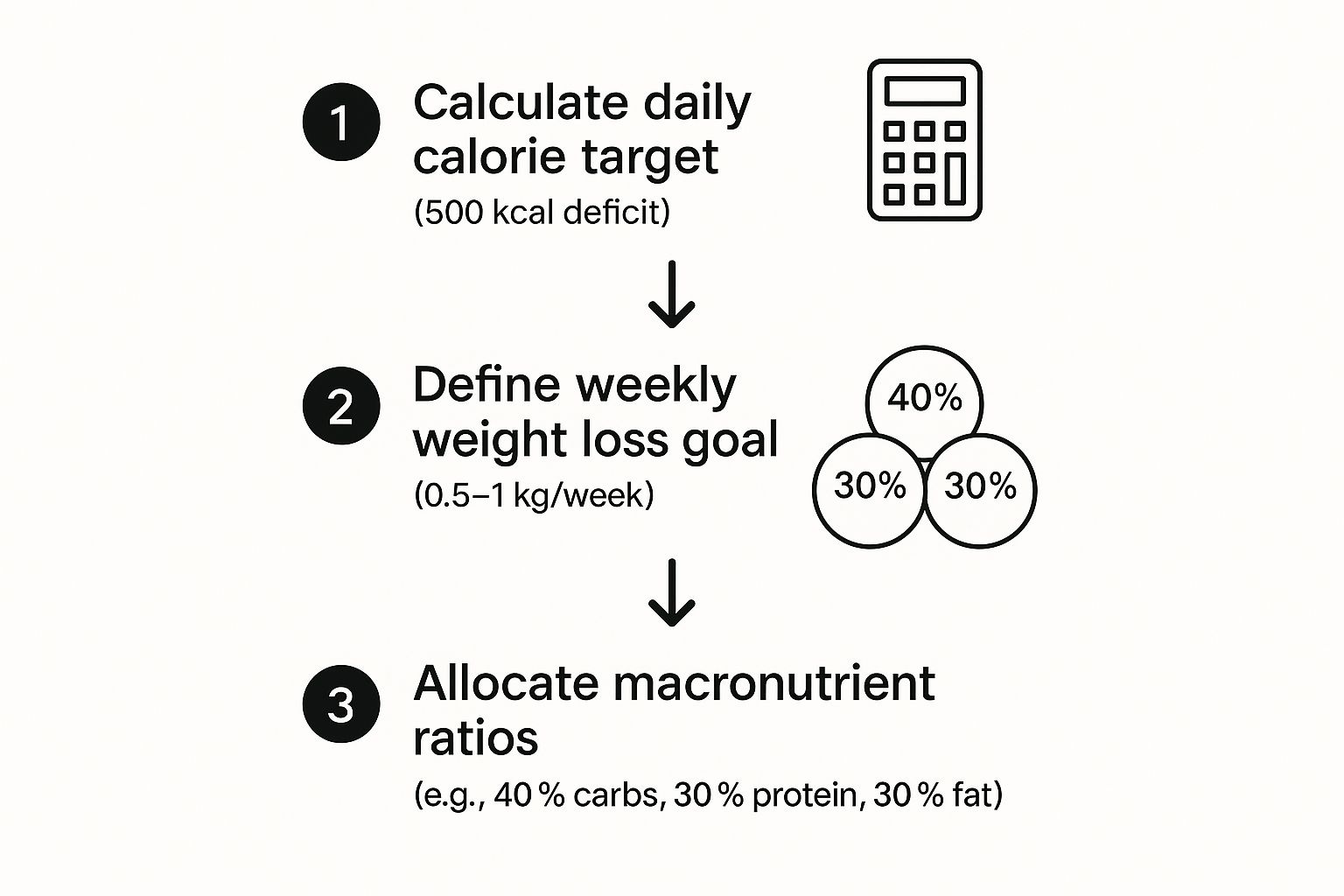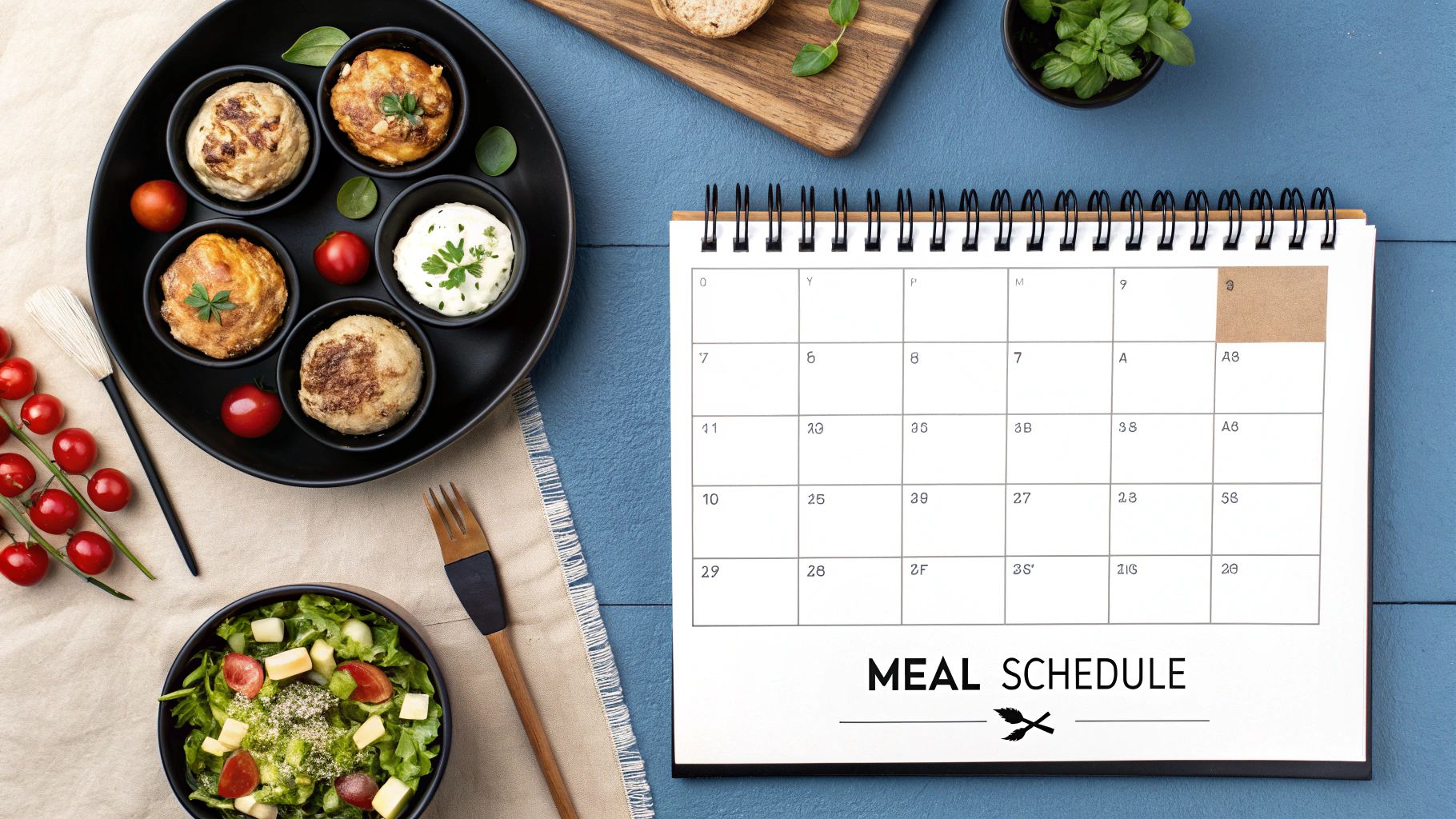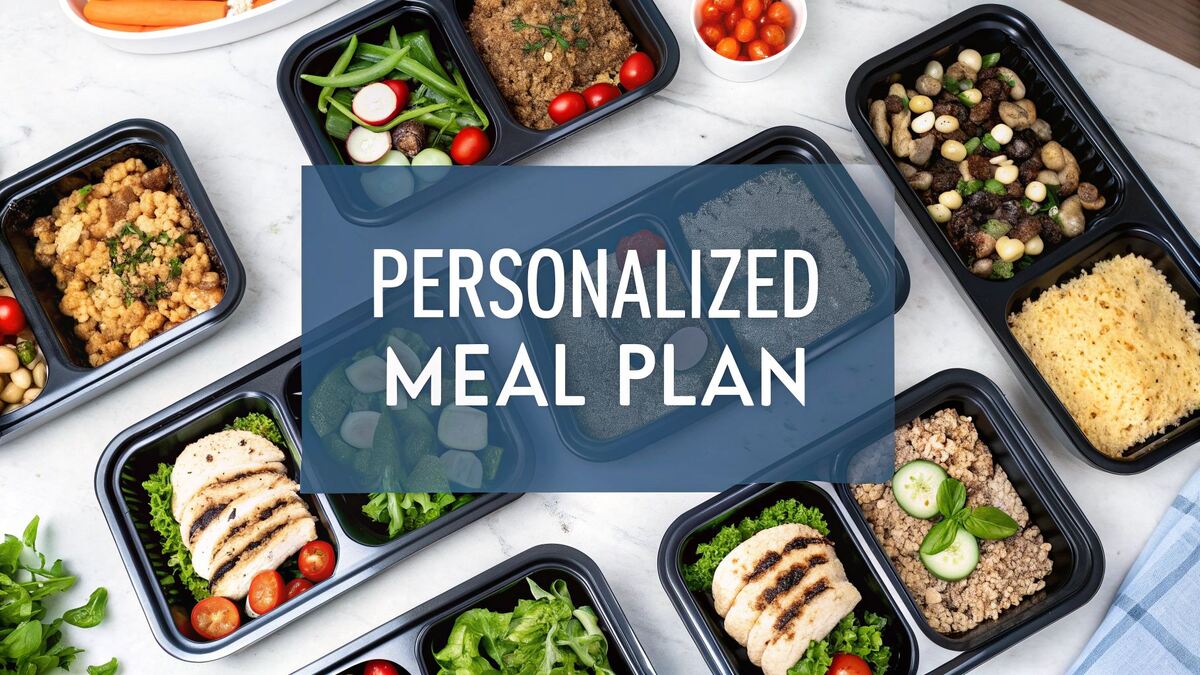Your Personalized Meal Plan for Weight Loss
A personalized weight-loss meal plan is more than just a list of foods; it's a strategic eating guide designed specifically for your body, your schedule, and your tastes. Unlike generic diets that treat everyone the same, this approach builds a sustainable path to weight loss because it works with you, not against you.
It’s all about creating a system that feels natural and energizing, rather than restrictive.
Why Generic Meal Plans Fail You
Have you ever jumped on a popular diet trend, followed it perfectly for a week, and then crashed and burned out of pure frustration? You’re definitely not alone. The biggest problem with one-size-fits-all meal plans is that they’re designed for a mythical "average" person who simply doesn't exist.
These rigid plans fall apart because they completely ignore what makes you, you. They don't factor in your unique metabolism, your crazy work schedule, or the simple fact that you might just hate kale. This creates a painful cycle: you restrict, you get cravings, you give in, and the weight comes back. It leaves you feeling worse than when you started.
The truth is, lasting weight loss isn't about finding a perfect set of rules. It’s about building a plan that fits your real life.
The Illusion of a Quick Fix
Generic diets often sell a tempting promise: a fast, easy solution. They hand you restrictive lists of "good" and "bad" foods, which can create a really unhealthy relationship with eating. This black-and-white thinking misses the most important thing in nutrition science: context. A banana isn't bad, but a diet of only bananas? That's a different story.
This mindset sets you up to fail. When you inevitably crave something on the "forbidden" list, it feels like a personal weakness instead of what it is—a normal biological signal. A truly effective personalized meal plan for weight loss ditches this rigid view. Instead, it teaches you how to fit all the foods you enjoy into a balanced approach that still gets you to your goals.
Ignoring Your Body's Unique Blueprint
Your body isn't a simple calculator where calories in minus calories out is the only thing that matters. So many things influence how you process food and lose weight, including:
- Metabolism: Your basal metabolic rate (BMR)—the energy your body uses just to stay alive—is unique. A generic 1,500-calorie diet might be perfect for one person, but for someone else, it could be so restrictive that it causes muscle loss and actually slows their metabolism down.
- Activity Level: A plan designed for someone who works at a desk all day won't provide nearly enough fuel for a person who loves hitting the gym for high-intensity workouts.
- Food Sensitivities and Preferences: Trying to force down foods you can't stand or that upset your stomach is a surefire way to quit. Actually enjoying your food is a huge part of sticking with any plan long-term.
To truly see the difference, let's break it down.
Generic vs Personalized Meal Plans at a Glance
The table below highlights the fundamental differences between a standard, cookie-cutter diet and a truly personalized nutrition strategy. It's easy to see why one approach leads to frustration while the other fosters sustainable success.
| Feature | Generic Diet Plan | Personalized Meal Plan |
|---|---|---|
| Foundation | Based on an "average" person; one-size-fits-all | Built around your unique BMR, activity, and goals |
| Food Choices | Rigid lists of "good" and "bad" foods | Flexible, incorporating foods you actually enjoy |
| Adaptability | Static and hard to adjust | Dynamic; easily adapts to your changing schedule and needs |
| Long-Term Success | Low; often leads to yo-yo dieting | High; promotes sustainable habits and lifestyle changes |
| Psychological Impact | Can create feelings of guilt and failure | Fosters a positive relationship with food and your body |
Ultimately, a personalized plan isn't just a list of recipes; it's a tool that empowers you to understand your body's needs and build healthy habits that last a lifetime.
The secret to a successful weight loss journey is adaptation. Your plan has to be flexible enough to bend with the realities of your life—hectic weeks, birthday parties, and low-energy days—without breaking.
The proof is in the results. For example, evidence-based programs consistently show that tailored nutrition works. People following personalized plans, like those offered by the Mayo Clinic Diet, often report losing 6 to 10 pounds in the first two weeks alone. This just shows the power of matching your nutrition to your individual needs.
The Power of a Personalized Approach
Making the switch from a generic to a personalized mindset is the single most important step you can take toward getting results that actually last. A plan designed just for you takes everything into account, making it feel like a seamless part of your lifestyle. This is where modern tools can be a game-changer, helping you build a roadmap that’s both effective and enjoyable. Check out the AI Meal Planner at https://ai-mealplan.com/plans to see what a truly customized experience can look like.
If you want to dig deeper into the science, these expert insights on speeding up metabolism and comparing different meal frequency approaches for weight loss are a great resource. A personalized meal plan transforms eating from a chore into your most powerful tool for hitting your health goals.
Finding Your Foundational Numbers
Before you can even think about what food to put on your plate, you need to get a handle on your body's unique energy needs. This isn't about plucking a random calorie number out of thin air. It's about figuring out the core numbers that will act as the blueprint for your entire weight loss plan.
First up is your Basal Metabolic Rate (BMR). Think of this as the bare minimum number of calories your body needs just to keep the lights on—powering your brain, lungs, and heart while you’re lying perfectly still. It's your personal energy baseline, and it's different for everyone.
From there, we get to your Total Daily Energy Expenditure (TDEE). This is the more practical number, accounting for your BMR plus all your daily activity. It includes everything from your morning workout to walking the dog and even the energy it takes to digest your food. This is a much truer picture of how many calories you actually burn in a day.
From TDEE to a Smart Calorie Target
Your TDEE is the magic number. It tells you your "maintenance" calories—what you’d need to eat to stay exactly where you are. To lose weight in a sustainable way, the goal is to create a small, consistent calorie deficit.
I see this all the time: people slash their calories way too drastically. This can seriously backfire. Your metabolism might slow down, and your body could start burning precious muscle instead of fat, making long-term success that much harder.
A much safer and more effective approach is a moderate deficit. Most nutrition experts agree that aiming for 250 to 500 calories below your TDEE is the sweet spot. This encourages steady, healthy weight loss without leaving you feeling ravenous or completely drained of energy.
 As you can see, a sensible calorie deficit is the starting point that directly informs your weekly goals and how you'll balance your macros.
As you can see, a sensible calorie deficit is the starting point that directly informs your weekly goals and how you'll balance your macros.Translating Calories into Macronutrients
Your total calorie count is critical, but the quality of those calories is just as important. This is where your macronutrients—protein, carbs, and fats—enter the picture. A well-designed plan balances these to support your body while you lose weight.
- Protein: This is your best friend during weight loss. Not only does it help you feel fuller for longer (which is a huge help with cravings), but it's also essential for preserving muscle mass as you slim down. A great starting point for most people is to get about 30% of daily calories from protein.
- Fats: Don't fear the fat! Healthy fats are vital for hormone production and overall well-being. They also help you feel satisfied after meals. Aiming for around 30% of your calories from sources like avocados, nuts, and olive oil is a solid strategy.
- Carbohydrates: Carbs are your body's go-to energy source, fueling your brain and powering your workouts. The remaining 40% of your calories can come from complex carbs like vegetables, fruits, and whole grains for slow, sustained energy.
If you really want to dial things in, you might consider using a glucose monitor for weight loss. It can give you incredible insight into how your body personally responds to different foods, especially carbs, letting you make even smarter tweaks to your plan.
Putting It All Together for Your Plan
Let's walk through a real-world example. Say someone calculates their TDEE at 2,200 calories. To create a 500-calorie deficit for steady weight loss, their new daily target becomes 1,700 calories.
Applying the macro split we just discussed, their daily goals would look like this:
- Protein (30%): 128 grams
- Fat (30%): 57 grams
- Carbohydrates (40%): 170 grams
Suddenly, these aren't just abstract numbers anymore. They become actionable targets. This gives you a clear framework for building meals that will keep you full, energized, and on track. Knowing these foundational numbers removes all the guesswork and empowers you to make smart choices every single day.
You can get a quick snapshot of where you stand by using our easy-to-use BMI calculator. While it isn't a direct measure of BMR or TDEE, it's a helpful starting point for understanding your current health status.
Building Meals You Genuinely Enjoy

Alright, you've got your calorie and macro targets. Think of those as the blueprint for your house. Now comes the fun part: picking out the furniture and making it a place you actually want to live. This is where we turn those numbers into delicious, satisfying food.
The best personalized meal plan for weight loss isn't about white-knuckling it through meals you hate. It’s about building a menu you look forward to eating. That’s the real secret to sticking with it for the long haul. Let’s ditch the whole "good food" vs. "bad food" mindset and focus on creating plates packed with nutrient-dense options you truly love.
Start With a Grocery List You Don’t Dread
Forget those hyper-restrictive shopping lists that banish everything you enjoy. A smart plan begins with the healthy foods you already like. What are your go-to proteins? Your favorite veggies? Those are your foundation.
This way, your kitchen is stocked with ingredients that inspire you, not ones that feel like a punishment. A simple but effective way to organize your list is by macronutrient, which ties directly back to the numbers we figured out earlier.
Here’s a simple way to think about it:
- Lean Proteins: These are your best friends for feeling full and maintaining muscle. Think chicken breast, fish like salmon or cod, Greek yogurt, eggs, lentils, and tofu.
- Complex Carbohydrates: You need these for steady energy. Stock up on things like quinoa, brown rice, sweet potatoes, oats, and whole-grain bread.
- Healthy Fats: Crucial for hormones and flavor. Make sure you have avocados, nuts, seeds, and some good extra virgin olive oil on hand.
- Veggies & Fruits: The more color, the better. Load your cart with spinach, broccoli, bell peppers, berries, and apples for a serious dose of vitamins, minerals, and fiber.
When your list is built around these core groups, you've got the building blocks for countless meal combinations that hit your macros without ever feeling repetitive.
Borrowing from Proven Eating Styles
You don’t have to reinvent the wheel here. Instead of forcing yourself into a rigid, named diet, you can borrow the best principles from well-researched eating patterns and use them as a flexible guide.
For years, dietary patterns like the Mediterranean diet have topped the charts for a reason—they work. They focus on whole foods, healthy fats, and tons of produce without being overly restrictive. This makes them incredibly adaptable. You can see how these diets stack up and find one whose principles resonate with you.
Think of these frameworks as a compass, not a cage. The Mediterranean style might inspire you to use more olive oil and eat more fish, but it doesn’t mean you have to give up your favorite taco night. The key is to adapt the principles to your own preferences.
This gives your plan some much-needed structure without sacrificing the personalization that makes it sustainable.
How to Build a Satisfying Plate
So, how does this look in the real world? One of the most effective tools I use with clients is a simple visualization technique for building a balanced plate. It helps you hit your macro goals without having to weigh and measure every single thing.
The Balanced Plate Method Just imagine your plate is divided into a few key sections:
| Plate Section | Nutrient Focus | What It Looks Like |
|---|---|---|
| Half the Plate | Fiber & Micronutrients | A big pile of leafy greens, roasted broccoli, bell peppers, asparagus, or a mixed salad. |
| Quarter of the Plate | Lean Protein | A palm-sized portion of grilled chicken, salmon, or a good scoop of lentils. |
| Quarter of the Plate | Complex Carbs | A fist-sized serving of quinoa, sweet potato, or brown rice. |
| A Drizzle or Sprinkle | Healthy Fats | A thumb-sized amount of avocado, a sprinkle of nuts, or a drizzle of olive oil dressing. |
This visual cue is incredibly powerful. It ensures your meals are nutritionally complete, keeping you full and energized, which makes sticking to a calorie deficit so much easier. Suddenly, building a healthy meal isn't a math problem—it's an intuitive, creative process.
By combining foods you love with these flexible frameworks, you're not just on a diet; you're creating a sustainable eating style. To see this in action, you can explore how the AI Meal Planner helps you build these meals by automatically weaving your favorite foods into a perfectly structured plan.
Designing Your Week for Real Life
Let’s be honest. A theoretically perfect meal plan is worthless if it doesn't fit into your actual, messy, unpredictable life. This is where we get real. The whole point isn't to force your life to revolve around food; it's to create an eating structure that supports you and makes staying on track feel natural.
This means planning around your job, your workouts, and yes, even that last-minute dinner invitation. A truly effective personalized meal plan for weight loss has to be resilient. It needs to bend without breaking, letting you handle whatever life throws at you while still making progress.
Meal Prepping Without Losing Your Sunday
The very idea of "meal prep" can be a little intimidating. It often brings to mind images of someone spending their entire Sunday stuck in the kitchen, surrounded by a mountain of Tupperware. It really doesn't have to be an all-or-nothing thing. The trick is to find a prep style that gives you the biggest bang for your buck, time-wise.
Instead of cooking every single meal for the entire week, you can take a much smarter approach.
- Try Component Prepping: This has been a game-changer for so many people. Instead of making complete meals, just cook the building blocks. Think grilling a big batch of chicken breasts, roasting a tray of colorful veggies, and making a pot of quinoa. Now you have a fridge full of options to mix and match for super-fast, fresh meals.
- Focus on Your Pain Points: What’s the one meal that consistently trips you up? For a lot of us, it’s lunch during a hectic workday. So, concentrate your prep efforts there. Just having four or five healthy lunches ready to go can be the single thing that stops you from ordering takeout.
- Embrace the "Cook Once, Eat Twice" Rule: This is the easiest form of prep there is. Whenever you’re cooking a healthy dinner you love, just make double. Instantly, you’ve got a delicious, perfectly portioned lunch for the next day with zero extra time spent.
By using one of these flexible methods, you get your weekend back and set yourself up for a successful week.
Planning for Life's Curveballs
Your plan has to have room for reality. Life is full of birthday parties, happy hours, and days where you're just too wiped out to even think about cooking. A rigid plan will shatter at the first sign of pressure, but a flexible one adapts. This is exactly where the 80/20 rule comes into play.
The 80/20 rule is less of a rule and more of a mindset shift. It's about aiming to stick to your plan about 80% of the time, leaving the other 20% for those real-life moments. This isn't "cheating"—it's a sustainable strategy that prevents burnout and the guilt that so often kills progress.
This mindset gives you the freedom to have a slice of cake at a party or a glass of wine with friends without feeling like you've failed. You just acknowledge it, enjoy the moment, and get right back on track with your next meal. No drama. It’s a much healthier way to think about food and makes the whole journey more enjoyable.
Syncing Your Meals with Your Schedule
Timing is another piece of the puzzle that generic plans totally miss. When you eat can be just as important as what you eat, especially for keeping your energy levels stable and fueling your workouts.
Take a second to think about your typical weekly rhythm and plan around it.
- Workout Nutrition: If you have an intense gym session planned, what you eat before and after is huge. You’ll want some easily digestible carbs about an hour beforehand for energy and a mix of protein and carbs afterward to help your muscles recover. A banana before and a protein shake with a small apple after is a classic for a reason.
- The 3 PM Slump: Do you always get snacky in the mid-afternoon? Plan for it! Instead of fighting that urge, build a healthy, protein-heavy snack right into your day—think Greek yogurt or a handful of almonds. This way, you’re prepared and won’t be tempted by the vending machine.
To give you a clearer picture, here's what a flexible day might look like.
Sample Flexible Meal Structure
This table gives a great example of how you can structure your day to hit your nutritional targets while still having room to move things around.
| Meal Time | Component Focus | Example Foods |
|---|---|---|
| 8:00 AM | Protein & Fiber for Fullness | Scrambled eggs with spinach and a side of berries |
| 12:30 PM | Balanced Macros for Sustained Energy | Grilled chicken salad with quinoa and avocado dressing |
| 4:00 PM | Protein Snack to Bridge the Gap | Greek yogurt with a sprinkle of nuts |
| 7:00 PM | Lean Protein & Veggies | Baked salmon with roasted asparagus and sweet potato |
Remember, this structure is just a guide, not a set of strict rules. Those times can easily shift based on your meetings, workouts, or family life. The goal is simply to have a reliable framework that you can adapt on the fly, making your meal plan a true partner on your weight loss journey.
Tracking Progress and Making Smart Adjustments
Here’s a hard truth: the perfect meal plan you create today won't be the perfect plan six months from now. Your body is constantly changing and adapting, so your plan needs to adapt right along with it. Think of your meal plan less like a rigid set of rules and more like a roadmap—sometimes you’ll hit a detour and need to find a new route.
The secret to long-term success isn't just following a plan; it's learning how to listen to your body and make smart tweaks along the way. This is how you go from "being on a diet" to building a sustainable lifestyle you can actually stick with.
Moving Beyond the Scale
Look, I get it. The number on the scale can feel like the final grade on your report card. But fixating on that number is a classic rookie mistake. Your weight can jump around day-to-day thanks to water, hormones, or even a salty meal. Relying only on the scale is a surefire way to get discouraged and miss the real signs you’re making progress.
Instead, let’s focus on the clues that tell the whole story. These are the things that really matter.
- The Fit of Your Clothes: This is often the first "aha!" moment. When your favorite jeans slide on a little easier or that shirt isn’t pulling across your back anymore, that’s real, undeniable progress. It’s a feeling no number on a scale can replicate.
- Body Measurements: Grab a soft tape measure and, once or twice a month, jot down the numbers for your waist, hips, and thighs. It's incredibly motivating to see you've lost an inch off your waist, even if the scale hasn’t budged an ounce.
- Progress Photos: They might feel awkward at first, but trust me on this. Snap a few photos (front, side, and back) every four weeks. Use the same outfit and lighting if you can. The visual changes you’ll see over time are often staggering and something you’d completely miss just by glancing in the mirror every day.
- Your Energy and Mood: How do you feel? Are you waking up feeling rested? Do you have the energy to get through that 3 PM slump without reaching for a snack? These are huge wins that prove you’re nourishing your body correctly.
When you track these things, you get a much richer, more accurate picture of how far you've come.
Recognizing and Breaking Through a Plateau
Sooner or later, it happens to everyone: the dreaded plateau. You were cruising along, seeing great results, and then… nothing. The scale is stuck. Your measurements won't move. It's frustrating, but it's a completely normal part of the process. It doesn't mean you've failed; it just means your body has adapted.
A plateau is your body's way of saying, "Okay, I'm used to this now." As you lose weight, your metabolism naturally adjusts because a smaller body simply needs less fuel to run. What worked a month ago might not be enough to create a deficit today.
The absolute worst thing you can do here is panic. Don't drastically slash your calories or start chaining yourself to the treadmill. That's a recipe for burnout. Instead, we just need to make a small, strategic shift. A simple and highly effective move is to reduce your daily calorie target by a modest 100-150 calories. It's just enough to get the ball rolling again without feeling like you're starving.
How to Adjust Your Plan Intelligently
Let's imagine you’ve been on a 1,700-calorie plan and things have stalled out for a few weeks. It's time to adjust. Our new goal is to land somewhere between 1,550-1,600 calories.
But how do you trim those calories without feeling deprived? Here are a few simple ways you could do it:
| Adjustment Method | Example Action | Calorie Impact |
|---|---|---|
| Reduce Cooking Fats | Use one tablespoon of olive oil in the pan instead of two. | ~120 calories saved |
| Swap Your Carb | Switch out one cup of rice for one cup of riced cauliflower at dinner. | ~150 calories saved |
| Right-Size a Portion | Instead of a big handful of almonds, use a measured quarter-cup. | ~50-80 calories saved |
| Optimize a Snack | Trade your usual protein bar for a scoop of plain Greek yogurt. | ~100 calories saved |
You don’t have to do all of these at once! Just pick one or two that seem easiest to you. Make the change, then give your body at least two weeks to respond before you analyze the results. This patient cycle of tracking, adjusting, and reassessing is what ensures your plan always works for you, keeping you on track for the long haul.
Still Have Questions About Personalized Meal Plans?

Starting any new health journey brings up a ton of questions. As you get into your personalized meal plan for weight loss, it's only natural to wonder how to handle real-life scenarios, stay on track, and make sure you're doing it right. Honestly, getting solid answers to these common worries is what gives you the confidence to stick with it.
Let's dive into some of the questions I hear all the time. We’ll cover practical advice for everything from grabbing dinner with friends to fighting off cravings, so you feel equipped to handle whatever life throws at you.
How Do I Handle Eating Out at Restaurants?
Going out to eat doesn't mean you have to toss your goals out the window. In fact, learning how to handle a restaurant menu is a skill you'll need for long-term success. The trick is to have a game plan before you even walk in the door.
Nearly every restaurant has its menu online. Before you go, take five minutes to scan it and pick out a couple of solid, healthy options. This one tiny step saves you from making a last-minute, hunger-fueled decision when you’re surrounded by tempting smells.
When it’s time to order, zero in on words like "grilled," "baked," or "steamed" instead of "fried." And don't ever be afraid to ask for a few simple changes. Things like:
- Getting the dressing for your salad on the side.
- Asking for steamed veggies instead of fries.
- Swapping a heavy cream sauce for a lighter tomato-based one.
These little tweaks make a massive difference. They let you enjoy a meal with people you care about without feeling like you've strayed from your path.
What if I Have a Bad Day and Go Off-Plan?
First off, it's going to happen. Everyone has an off day. It’s part of being human. What truly matters isn't the slip-up itself, but how you bounce back from it. One meal or one day of not-so-great choices doesn't undo weeks of progress.
The goal is consistency, not perfection. Think of an off-plan meal as a single blip on the radar of your entire journey. The only real damage comes from letting guilt and frustration turn that one blip into a week of bad choices.
Don't beat yourself up. Just get right back on track with your next meal. Acknowledge it, forget it, and move on. I always tell people to think about the 80/20 rule—if you’re making smart choices 80% of the time, you're still doing an amazing job and will see results.
Will I Have to Give Up All My Favorite Foods Forever?
Not a chance. For any plan to work, it has to be sustainable. Completely forbidding the foods you genuinely love is the quickest route to feeling miserable and giving up. The real goal is learning how to incorporate those foods into your life in a balanced, thoughtful way.
If you love pizza, plan for it. There's nothing wrong with having a slice or two, especially if you pair it with a big, nutrient-packed salad. This strategy lets you satisfy a craving without derailing your calorie goals. It’s all about finding a healthy middle ground, not living in a world of restriction. This shift in thinking is what turns a "diet" into a lifestyle you can actually maintain.
Ready to take the guesswork out of the equation? The AI Meal Planner is designed to build a plan that truly works for you. It creates a delicious, effective, and fully personalized meal plan for weight loss in just a few minutes. See for yourself how easy it can be to reach your goals.
AI-powered nutrition
Get Your Personalized Meal Plan
AI creates the perfect meals for your goals, lifestyle, and taste.
Start Your Journej
